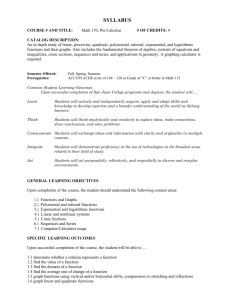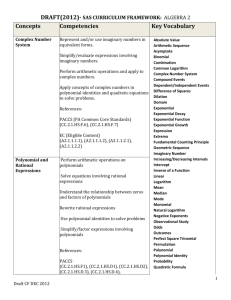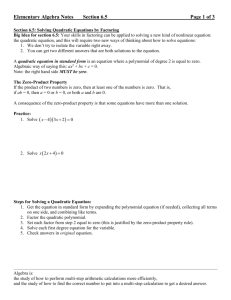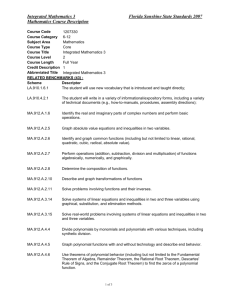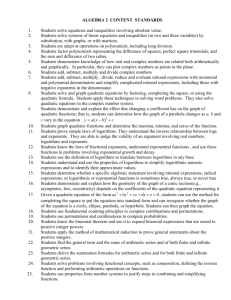Algebra 1 Topics and Preparation for Non
advertisement
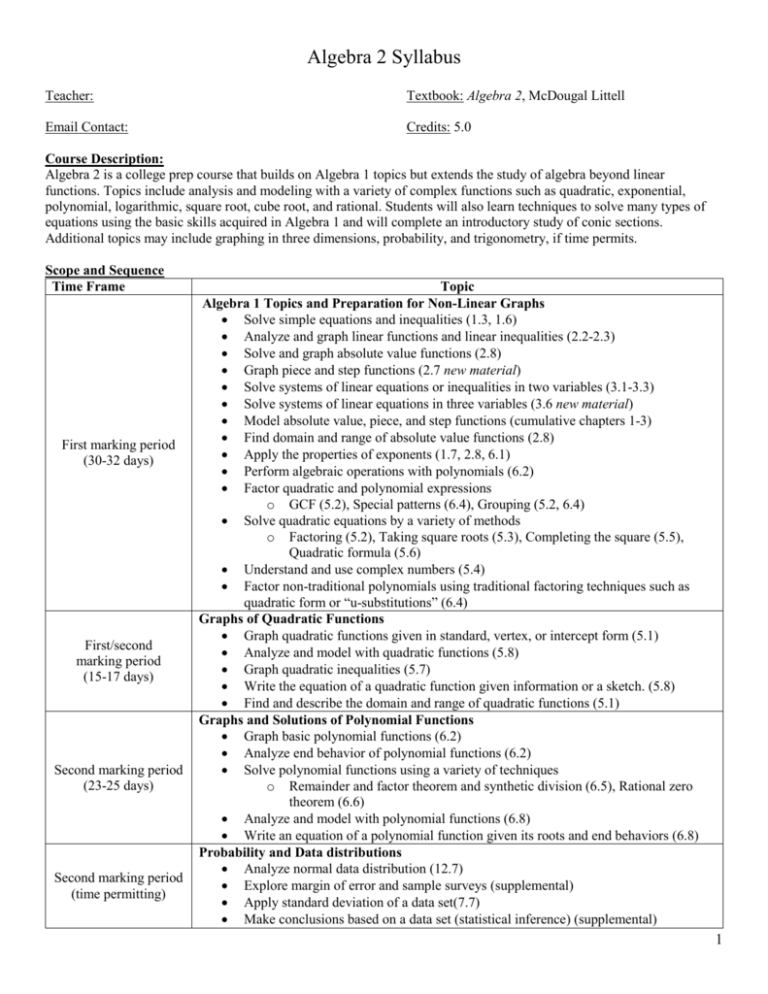
Algebra 2 Syllabus Teacher: Textbook: Algebra 2, McDougal Littell Email Contact: Credits: 5.0 Course Description: Algebra 2 is a college prep course that builds on Algebra 1 topics but extends the study of algebra beyond linear functions. Topics include analysis and modeling with a variety of complex functions such as quadratic, exponential, polynomial, logarithmic, square root, cube root, and rational. Students will also learn techniques to solve many types of equations using the basic skills acquired in Algebra 1 and will complete an introductory study of conic sections. Additional topics may include graphing in three dimensions, probability, and trigonometry, if time permits. Scope and Sequence Time Frame First marking period (30-32 days) First/second marking period (15-17 days) Second marking period (23-25 days) Second marking period (time permitting) Topic Algebra 1 Topics and Preparation for Non-Linear Graphs Solve simple equations and inequalities (1.3, 1.6) Analyze and graph linear functions and linear inequalities (2.2-2.3) Solve and graph absolute value functions (2.8) Graph piece and step functions (2.7 new material) Solve systems of linear equations or inequalities in two variables (3.1-3.3) Solve systems of linear equations in three variables (3.6 new material) Model absolute value, piece, and step functions (cumulative chapters 1-3) Find domain and range of absolute value functions (2.8) Apply the properties of exponents (1.7, 2.8, 6.1) Perform algebraic operations with polynomials (6.2) Factor quadratic and polynomial expressions o GCF (5.2), Special patterns (6.4), Grouping (5.2, 6.4) Solve quadratic equations by a variety of methods o Factoring (5.2), Taking square roots (5.3), Completing the square (5.5), Quadratic formula (5.6) Understand and use complex numbers (5.4) Factor non-traditional polynomials using traditional factoring techniques such as quadratic form or “u-substitutions” (6.4) Graphs of Quadratic Functions Graph quadratic functions given in standard, vertex, or intercept form (5.1) Analyze and model with quadratic functions (5.8) Graph quadratic inequalities (5.7) Write the equation of a quadratic function given information or a sketch. (5.8) Find and describe the domain and range of quadratic functions (5.1) Graphs and Solutions of Polynomial Functions Graph basic polynomial functions (6.2) Analyze end behavior of polynomial functions (6.2) Solve polynomial functions using a variety of techniques o Remainder and factor theorem and synthetic division (6.5), Rational zero theorem (6.6) Analyze and model with polynomial functions (6.8) Write an equation of a polynomial function given its roots and end behaviors (6.8) Probability and Data distributions Analyze normal data distribution (12.7) Explore margin of error and sample surveys (supplemental) Apply standard deviation of a data set(7.7) Make conclusions based on a data set (statistical inference) (supplemental) 1 Algebra 2 Syllabus Time Frame Third marking period (18-20 days) Third marking period (18-20 days) Third/fourth marking period (23-25 days) Fourth marking period (13-15 days) Fourth marking period (time Permitting) Topic Rational Expressions, Equations, and Functions Multiply and divide rational expressions (9.4) Simplify complex fractions and add and subtract rational expressions (9.5) Solve rational equations (9.6) Graph rational functions (9.2-9.3) Analyze direct, inverse, and joint variation (9.1) Asymptotes and domain and range Powers, Roots and Radicals Apply properties of rational exponents and nth roots (7.1-7.2) Explore power functions and perform composition of functions (7.3) Graph and analyze inverse functions (7.4) Graph square root and cube root functions (7.5) Solve radical equations (7.6) Focus on domain and range as related to these functions Exponential and Logarithmic Functions Graph and analyze types of exponential functions (8.1 and 8.2) Introduce logarithms and graph logarithmic functions (8.4) Apply properties of logarithms and common logarithms (8.5) Solve exponential and logarithmic equations (8.6) Explore the number e and continuous growth and decay (8.3) Model with exponential, logarithmic, and power functions (8.7) Conic Sections Use distance and midpoint formula (10.1) Explore all types of conic sections with their important elements o Parabolas (directrix, focus, and opening in any direction) (10.2) o Circles (10.3) o Ellipses (foci) (10.4) o Hyperbolas (foci, asymptotes) (10.5) Solve systems of conic sections graphically and by quadratic techniques (10.7) Classify all families of functions learned to this point (10.6) Write the equation of a conic section given important information or a sketch of the graph not centered at the origin (10.6) Trigonometric Functions Pythagorean Identity (14.3) Explore the unit circle and evaluate trigonometric functions at any degree or radian measure on a coordinate plane (13.2) Basic graphs and transformations of trigonometric functions (14.1) Analyze periodicity, amplitude, and zeroes (14.1) 2
